A Paipo
Interview with Mitsuo "Michan" Uenoyama
July 24, 2013 - Zaimokuza Beach, Kamakura
Interview and photos by John Clark
Conventional
wisdom dates the origins of surfing in Japan
to U.S. surfers post-World War II. Postcards which featured small
wooden boards sparked questions regarding whether there was an
indigenous surfing culture. Wooden boards that became known as known as
itago, or "itako," were floor boards
lining
the bottom of fishing boats.
These boards also served a life saving purpose and later would be used
to ride waves — itako-nori is the act of riding these wooden
boards.
Mitsuo "Michan" Uenoyama rented these boards to tourists at Zaimokuza
Beach, over a period of many years. On a visit to Japan, John Clark,
with the assistance of his son Koji as his translator, met with Michan
and asked
about his experiences with itago-nori boards.
(Right) Photo of Michan holding an itago
board. Courtesy of John Clark.
|
|
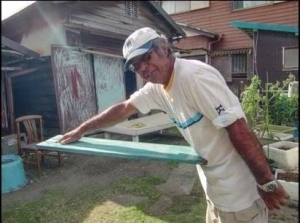
|
|
Introduction
by John Clark
In 2007, my family and I visited Japan. My
wife, Julie Ushio, is a
sansei (third generation Japanese in the U.S.), so one of the main
reasons for our visit was for me and our two children, Sachi and Koji,
to meet her family at Iimori Shrine in Fukuoka. On our way from Tokyo
to Fukuoka, we stopped in Kamakura and stayed at the Kamakura Park
Hotel. There we met Mie Inage who works at the front desk. Mie speaks
English, and we soon learned that she is a bodyboard surfer. In the
years that followed our visit to Japan, Mie came to Hawaii several
times and stayed in Waikiki. She and I went surfing each time she came,
and we became good friends.
In 2011, the University of Hawaii Press published a book I wrote called
Hawaiian Surfing: Traditions from the Past. While
I was researching
traditional Hawaiian surfing, I also learned about itago-nori,
traditional surfing in Japan. I wanted to know more, so I checked on
the Internet and found a wonderful history of itago-nori on the
website
for Nobbywood Surfboards [see Note 1]. The
history was
written by Nobuhito "Nobby" Ohkawa, the owner of Nobbywood Surfboards.
I contacted him by email, and we began exchanging information about
surf history in Japan. I also contacted Mie about itago-nori,
and she
told me she knew a fisherman named Matsuo "Michan" Uenoyama who used to
rent itago boards on the beach in Kamakura.
(Below left)
John Clark on Waikiki
Beach with an Itago board from Michan. (Below right) Nobby
Ohkawa in his shop.
|
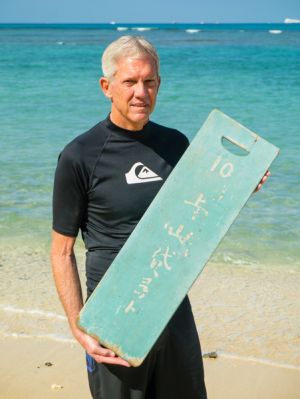
|
|
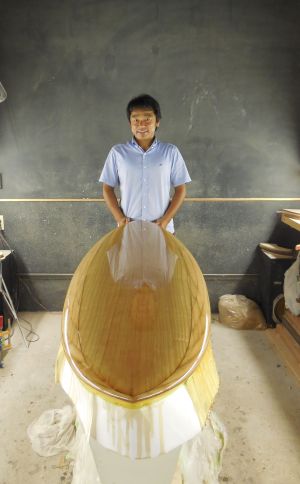
|
Photos by John Clark.
In 2013, my family and I returned to Japan. Our first stop was in
Chiba, where we met Nobby and visited his shop. In addition to seeing
the beautiful boards he makes, he showed us his collection of itago
boards, which includes one float board, a naminori furouto.
After
Chiba, we stayed again at the Kamakura Park Hotel, where Mie arranged
for me to meet and interview Michan. In addition to meeting Michan, we
made a side trip to the Oiso Municipal Museum, which has a nice
collection of itago boards (see below figures). Mitsuo Uenoyama
is a life-long
fisherman
who was born and raised in Kamakura, Japan. Like many fishermen in
Kamakura, he has a shop on Zaimokuza Beach where he stores his fishing
gear and rents rowboats and small sailboats. In the old days, he also
rented itago-nori and naminori furouto. The itago-nori
are small wood
bodyboards, which were ridden prone, and naminori furouto are
larger
hollow wood boards, which were ridden standing up. The rentals were a
side business to supplement his income from fishing.
(Below left)
Five itago
boards in the Oiso Municipal Museum. (Below right) The kappa, a
legendary Japanese
water creature, on one of the Oiso Municipal Museum itago
boards.
|
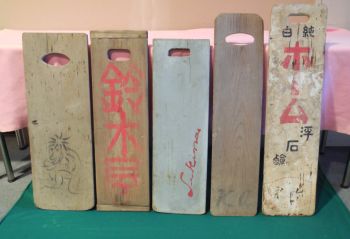
|
|
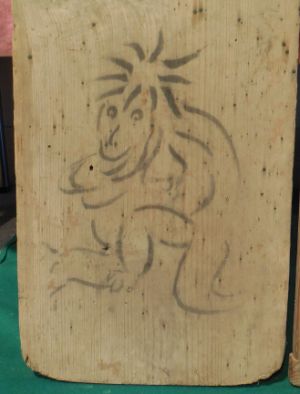
|
Photos by John Clark.
Mitsuo Uenoyama interview
Everyone knows Mitsuo as Michan. His family
home is in Zaimokuza, the
community just inland from the beach. His grandfather, Senzou Uenoyama,
was a fisherman who started the family's beach rental business on
Zaimokuza Beach in the early-1950s. The original shop was closer to the
harbor, which is to the east of the beach. Michan's shop now is on the
west side of the Zaimokuza lifeguard headquarters, where he asked me to
meet him. The lifeguards know him well and call him the original
"beachboy" of Zaimokuza Beach. They offered the use of their office for
the interview.
Michan was born in Kamakura on July 16, 1946. He was six years old when
he first started using the itago-nori and the naminori
furouto rental
boards in his grandfather's shop, so he started surfing in the
shorebreak at Zaimokuza Beach in the early-1950s. When he was 16, he
tried a surfboard from Hawaii. A professional baseball player from
Hawaii named Oodate brought a foam surfboard to Kamakura. It was the
board that Elvis Presley used in the movie Blue Hawaii (1961).
Oodate's
son lived in Kamakura, so Michan and his friends all tried the board.
In later years, when Oodate's son was renovating his house, he threw
away the historic Elvis Presley surfboard.
Although the men in his family have been fishermen for many
generations, Michan's father worked for Mitsubishi. He didn't help out
at his father's shop on Zaimokuza Beach, but Michan began helping his
grandfather there when he was in middle school. When he graduated from
high school, he worked full-time at the shop and eventually took it
over. He had 15 itago-nori boards and 20 naminori furouto
boards in his
shop. He charged 30 yen to rent the itago boards and 150 yen to
rent
the float boards. In addition to his shop, there were four other shops
on Zaimokuza Beach that rented boards.
(Below left)
Michan holding the nose of an itago
board. (Below right) Demonstrating the proper way to catch a breaker on
an itago for a fun ride to the shore.
|

|
|
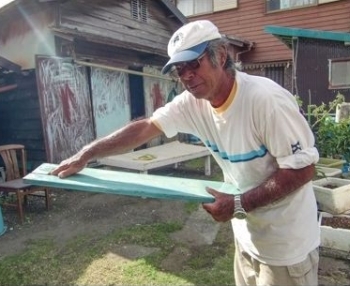
|
Photos by John Clark.
In the old days, there were many more people who came to the beach and
rented their equipment. People with breathing problems used to come to
Kamakura. His mother would come down to the shop three times a day and
take the money from the rentals to the bank. His stand was a popular
gathering place and attracted many girls.
Both the itago boards and the float boards were in use when he
was a
child. He doesn't know their history. The coast road along the beach
was built during the 1964 Tokyo Summer Olympics. Before that the
communities behind the beach were more isolated. In later years as wood
became more expensive and plastics were developed, interest in the old
wood boards died out. His boards were handmade by the man who made
their boats. The itago boards had a top piece and a bottom
piece (like
a tail block), but Michan didn't know why they were made that way.
These pieces were just nailed on the top and bottom of the boards. If
they came off, the nails would stick out, which was dangerous. The
nails were the same as the ones used to build temples.
He never saw the inside of a float board, so he doesn't know what the
interior frame looks like. Each of the boards had a mizu wonuku,
or a
drain plug. To catch a wave, a surfer would stand on the float board
and paddle with a wood paddle. Michan stood up and demonstrated the
movement, which was paddling with alternating strokes on either side of
the board. This was possible because the paddles had a blade at each
end of the handle, so the surfer held the middle of the handle and
paddled alternately on either side. Michan explained that if you were
going to grab the rope in front of the board, you put the paddle down
in the middle of the board between your legs, grabbed the rope, and
held it while you rode in. If you were a good surfer, however, you
didn't need to hold the rope.
(Below left)
Michan, Nobby,
Mie, and friend with the float board. (Below right) Nobby
demonstrates how to paddle a float board. Four itago boards are
against
the wall.
|
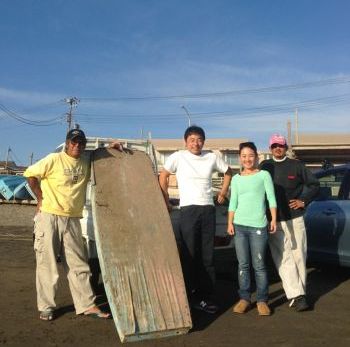
|
|
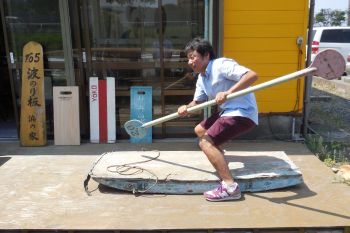
|
Photos by John Clark.
Today he only rents rowboats and small sailboats. The name of his shop
is the same as his last name, Uenoyama, which is the same for
all the
shops on the beach. The shop owners pay rent to the province to be on
the beach, and the amount they pay is determined by the size of the
shop.
|
Note 1: Nobby's website, Traditional
surfing in Japan: An unknown history, and a couple of the postcards
that sparked the
communication between Nobby Ohkawa and John Clark.
(Below left)
Yokohama-Wien:
1911, Japanese beauty in bath suit. (Below right) Oiso beach scene
pre-1950.
|
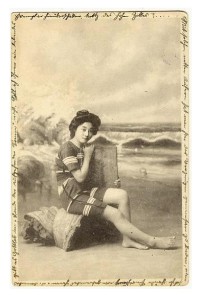 |
|
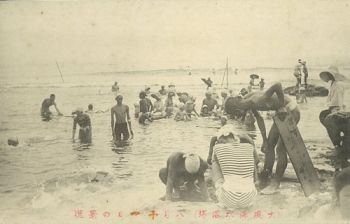
|
Source: Ohkawa, Nobuhito. (2012). Traditional surfing
in Japan: An unknown history. On the Internet at http://www.nobbywoodsurfboards.com/webpages/cn74/itago.html.
Other items of interest:
Video of John Clark
riding an itago at Waikiki, 2013. Click link
here or on the video below.
|
Filmed
and produced by Yusuke
Motohashi.
|
|
|